Compost
Compost (/ˈkɒmpɒst/ or /ˈkɒmpoʊst/) is organic matter that has been decomposed in a process called composting. This process recycles various organic materials otherwise regarded as waste products and produces a soil conditioner (the compost).
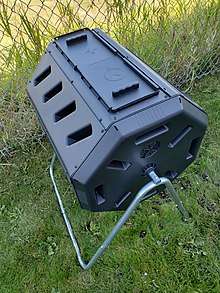
Compost is rich in nutrients. It is used, for example, in gardens, landscaping, horticulture, urban agriculture and organic farming. The compost itself is beneficial for the land in many ways, including as a soil conditioner, a fertilizer, addition of vital humus or humic acids, and as a natural pesticide for soil. Compost is useful for erosion control, land and stream reclamation, wetland construction, and as landfill cover.
At the simplest level, the process of composting requires making a heap of wet organic matter (also called green waste), such as leaves, grass, and food scraps, and waiting for the materials to break down into humus after a period of months. However, composting can also take place as a multi-step, closely monitored process with measured inputs of water, air, and carbon- and nitrogen-rich materials. The decomposition process is aided by shredding the plant matter, adding water and ensuring proper aeration by regularly turning the mixture when open piles or "windrows" are used. Fungi, earthworms and other detritivores further break up the material. Aerobic bacteria and fungi manage the chemical process by converting the inputs into heat, carbon dioxide, and ammonium.
Fundamentals
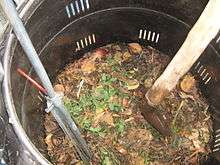
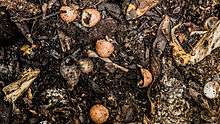
Composting is an aerobic method (meaning that it requires the presence of air) of decomposing organic solid wastes.[1] It can therefore be used to recycle organic material. The process involves decomposition of organic material into a humus-like material, known as compost, which is a good fertilizer for plants. Composting requires the following three components: human management, aerobic conditions, and development of internal biological heat.
Composting organisms require four equally important ingredients to work effectively:
- Carbon — for energy; the microbial oxidation of carbon produces the heat, if included at suggested levels.[2] High carbon materials tend to be brown and dry.
- Nitrogen — to grow and reproduce more organisms to oxidize the carbon. High nitrogen materials tend to be green (or colorful, such as fruits and vegetables) and wet.
- Oxygen — for oxidizing the carbon, the decomposition process.
- Water — in the right amounts to maintain activity without causing anaerobic conditions.[3]
Certain ratios of these materials will provide microorganisms to work at a rate that will heat up the pile. Active management of the pile (e.g. turning) is needed to maintain sufficient supply of oxygen and the right moisture level. The air/water balance is critical to maintaining high temperatures 130–160 °F (54–71 °C) until the materials are broken down.[4]
The most efficient composting occurs with an optimal carbon:nitrogen ratio of about 25:1.[5] Hot container composting focuses on retaining the heat to increase decomposition rate and produce compost more quickly. Rapid composting is favored by having a C/N ratio of ~30 or less. Above 30 the substrate is nitrogen starved, below 15 it is likely to outgas a portion of nitrogen as ammonia.[6]
Nearly all plant and animal materials have both carbon and nitrogen, but amounts vary widely, with characteristics noted above (dry/wet, brown/green).[7] Fresh grass clippings have an average ratio of about 15:1 and dry autumn leaves about 50:1 depending on species. Mixing equal parts by volume approximates the ideal C:N range. Few individual situations will provide the ideal mix of materials at any point. Observation of amounts, and consideration of different materials as a pile is built over time, can quickly achieve a workable technique for the individual situation.
Microorganisms
With the proper mixture of water, oxygen, carbon, and nitrogen, micro-organisms are able to break down organic matter to produce compost.[8][9] The composting process is dependent on micro-organisms to break down organic matter into compost. There are many types of microorganisms found in active compost of which the most common are:[10]
- Bacteria- The most numerous of all the microorganisms found in compost. Depending on the phase of composting, mesophilic or thermophilic bacteria may predominate.
- Actinobacteria- Necessary for breaking down paper products such as newspaper, bark, etc.
- Fungi- molds and yeast help break down materials that bacteria cannot, especially lignin in woody material.
- Protozoa- Help consume bacteria, fungi and micro organic particulates.
- Rotifers- Rotifers help control populations of bacteria and small protozoans.
In addition, earthworms not only ingest partly composted material, but also continually re-create aeration and drainage tunnels as they move through the compost.
Phases of composting
Under ideal conditions, composting proceeds through three major phases:[10]
- Mesophilic phase: An initial, mesophilic phase, in which the decomposition is carried out under moderate temperatures by mesophilic microorganisms.
- Thermophilic phase: As the temperature rises, a second, thermophilic phase starts, in which the decomposition is carried out by various thermophilic bacteria under high temperatures.
- Maturation phase: As the supply of high-energy compounds dwindles, the temperature starts to decrease, and the mesophiles once again predominate in the maturation phase.
Slow and rapid composting
There are many proponents of rapid composting that attempt to correct some of the perceived problems associated with traditional, slow composting. Many advocate that compost can be made in 2 to 3 weeks.[11] Many such short processes involve a few changes to traditional methods, including smaller, more homogenized pieces in the compost, controlling carbon-to-nitrogen ratio (C:N) at 30 to 1 or less, and monitoring the moisture level more carefully. However, none of these parameters differ significantly from the early writings of compost researchers, suggesting that, in fact, modern composting has not made significant advances over the traditional methods that take a few months to work. For this reason and others, many scientists who deal with carbon transformations are skeptical that there is a "super-charged" way to get nature to make compost rapidly.
Both sides may be right to some extent. The bacterial activity in rapid high heat methods breaks down the material to the extent that pathogens and seeds are destroyed, and the original feedstock is unrecognizable. At this stage, the compost can be used to prepare fields or other planting areas. However, most professionals recommend that the compost be given time to cure before using in a nursery for starting seeds or growing young plants. The curing time allows fungi to continue the decomposition process and eliminating phytotoxic substances.
An alternative approach is anaerobic fermentation, known as bokashi. It retains carbon bonds, is faster than decomposition, and for application to soil requires only rapid but thorough aeration rather than curing. It depends on sufficient carbohydrates in the treated material.
Pathogen removal
Composting can destroy pathogens or unwanted seeds. Unwanted living plants (or weeds) can be discouraged by covering with mulch/compost. The "microbial pesticides" in compost may include thermophiles and mesophiles.
Thermophilic (high-temperature) composting is well known to destroy many seeds and nearly all types of pathogens (exceptions may include prions). The sanitizing qualities of (thermophilic) composting are desirable where there is a high likelihood of pathogens, such as with manure.
Materials that can be composted
Composting is a process used for resource recovery. It can recycle an unwanted by-product from another process (a waste) into a useful new product.
Organic solid waste (green waste)
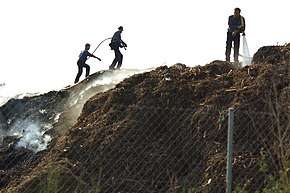
Composting is a process for converting decomposable organic materials into useful stable products. Therefore, valuable landfill space can be used for other wastes by composting these materials rather than dumping them on landfills. It may however be difficult to control inert and plastics contamination from municipal solid waste.
Co-composting is a technique that processes organic solid waste together with other input materials such as dewatered fecal sludge or sewage sludge.[5]
Industrial composting systems are being installed to treat organic solid waste and recycle it rather than landfilling it. It is one example of an advanced waste processing system. Mechanical sorting of mixed waste streams combined with anaerobic digestion or in-vessel composting is called mechanical biological treatment. It is increasingly being used in developed countries due to regulations controlling the amount of organic matter allowed in landfills. Treating biodegradable waste before it enters a landfill reduces global warming from fugitive methane; untreated waste breaks down anaerobically in a landfill, producing landfill gas that contains methane, a potent greenhouse gas.
Animal manure and bedding
On many farms, the basic composting ingredients are animal manure generated on the farm and bedding. Straw and sawdust are common bedding materials. Non-traditional bedding materials are also used, including newspaper and chopped cardboard. The amount of manure composted on a livestock farm is often determined by cleaning schedules, land availability, and weather conditions. Each type of manure has its own physical, chemical, and biological characteristics. Cattle and horse manures, when mixed with bedding, possess good qualities for composting. Swine manure, which is very wet and usually not mixed with bedding material, must be mixed with straw or similar raw materials. Poultry manure also must be blended with carbonaceous materials - those low in nitrogen preferred, such as sawdust or straw.[12]
Human waste and sewage sludge
Human waste can be added as an input to the composting process since human excreta is a nitrogen-rich organic material. It can be either composted directly, as in composting toilets, or indirectly (as sewage sludge), after it has undergone treatment in a sewage treatment plant. Feces contain a wide range of microorganisms including bacteria, viruses and parasitic worms and its use in home composting can pose significant health risks.[13]
Urine can be put on compost piles or directly used as fertilizer.[14] Adding urine to compost can increase temperatures and therefore increase its ability to destroy pathogens and unwanted seeds. Unlike feces, urine does not attract disease-spreading flies (such as houseflies or blowflies), and it does not contain the most hardy of pathogens, such as parasitic worm eggs.
Uses
Compost can be used as an additive to soil, or other matrices such as coir and peat, as a tilth improver, supplying humus and nutrients. It provides a rich growing medium as absorbent material (porous). This material contains moisture and soluble minerals, which provides support and nutrients. Although it is rarely used alone, plants can flourish from mixed soil, sand, grit, bark chips, vermiculite, perlite, or clay granules to produce loam. Compost can be tilled directly into the soil or growing medium to boost the level of organic matter and the overall fertility of the soil. Compost that is ready to be used as an additive is dark brown or even black with an earthy smell.[15]
Generally, direct seeding into a compost is not recommended due to the speed with which it may dry and the possible presence of phytotoxins in immature compost that may inhibit germination,[16][17][18] and the possible tie up of nitrogen by incompletely decomposed lignin.[19] It is very common to see blends of 20–30% compost used for transplanting seedlings at cotyledon stage or later.
Compost can be used to increase plant immunity to diseases and pests.[20]
Composting technologies
Various approaches have been developed to handle different ingredients, locations, throughput and applications for the composted product.
Industrial-scale
Industrial-scale composting can be carried out in the form of in-vessel composting, aerated static pile composting, vermicomposting, or windrow composting.
Vermicomposting
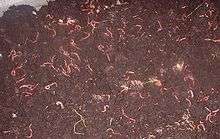
Vermicompost is the product or process of organic material degradation using various species of worms, usually red wigglers, white worms, and earthworms, to create a heterogeneous mixture of decomposing vegetable or food waste (excluding nitrogen-rich meat or dairy and fats or oils), bedding materials, and vermicast. Vermicast, also known as worm castings, worm humus or worm manure, is the end-product of the breakdown of organic matter by species of earthworm.[21]
Vermicomposting can also be applied for treatment of sewage sludge.
Composting toilets
.jpg)
A composting toilet collects human excreta. These are added to a compost heap that can be located in a chamber below the toilet seat. Sawdust and straw or other carbon rich materials are usually added as well. Some composting toilets do not require water or electricity; others may. If they do not use water for flushing they fall into the category of dry toilets. Some composting toilet designs use urine diversion, others do not. When properly managed, they do not smell. The composting process in these toilets destroys pathogens to some extent. The amount of pathogen destruction depends on the temperature (mesophilic or thermophilic conditions) and composting time.[22]
Composting toilets with a large composting container (of the type Clivus Multrum and derivations of it) are popular in United States, Canada, Australia, New Zealand and Sweden. They are available as commercial products, as designs for self builders or as "design derivatives" which are marketed under various names.
Black soldier fly larvae
Black soldier fly (Hermetia illucens) larvae are able to rapidly consume large amounts of organic material when kept at around 30 °C.[23][24] Black soldier fly larvae can reduce the dry matter of the organic waste by 73% and convert 16–22% of the dry matter in the waste to biomass.[25][26] The resulting compost still contains nutrients and can be used for biogas production, or further traditional composting or vermicomposting [27] The larvae are rich in fat and protein, and can be used as, for example, animal feed or biodiesel production.[28] Enthusiasts have experimented with a large number of different waste products.[29]
Bokashi
Bokashi is not composting as defined earlier, rather an alternative technology. It ferments (rather than decomposes) the input organic matter and feeds the result to the soil food web (rather than producing a soil conditioner). The process involves adding Lactobacilli to the input in an airtight container kept at normal room temperature. These bacteria ferment carbohydrates to lactic acid, which preserves the input. After this is complete the preserve is mixed into soil, converting the lactic acid to pyruvate, which enables soil life to consume the result.
Bokashi is typically applied to food waste from households, workplaces and catering establishments, because such waste normally holds a good proportion of carbohydrates; it is also applied to other organic waste by supplementing carbohydrates. Household containers ("bokashi bins") typically give a batch size of 5–10 kilograms (11–22 lb), accumulated over a few weeks. In horticultural settings batches can be orders of magnitude greater.
Bokashi offers several advantages:
- Fermentation retains all the original carbon and energy. (In comparison, composting loses at least 50% of these and 75% or more in amateur use; composting also loses nitrogen, a macronutrient of plants, by emitting ammonia and the potent greenhouse gas nitrous oxide.)[30]
- Virtually the full range of food waste is accepted, without the exclusions of composting. The exception is large bones.
- Being airtight, the container inherently traps smells, and when opened the smell of fermentation is far less offensive than decomposition. Hence bokashi bins usually operate indoors, in or near kitchens.
- Similarly the container neither attracts insect pests nor allows them ingress.
- The process is inherently hygienic because lactic acid is a natural bactericide and anti-pathogen; even its own fermentation is self-limiting.
- Both preservation and consumption complete within a few weeks rather than months.
- The preserve can be stored until needed, for example if ground is frozen or waterlogged.
- The increased activity of the soil food web improves the soil texture, especially by worm action - in effect this is in-soil vermicomposting.
The importance of the first advantage should not be underestimated: the mass of any ecosystem depends on the energy it captures. Plants depend upon the soil ecosystem making nutrients available within soil water. Therefore, the richer the ecosystem, the richer the plants. (Plants can also take up nutrients from added chemicals, but these are at odds with the purpose of composting).
Other systems at household level
Hügelkultur (raised garden beds or mounds)
.jpg)
The practice of making raised garden beds or mounds filled with rotting wood is also called hügelkultur in German.[31][32] It is in effect creating a nurse log that is covered with soil.
Benefits of hügelkultur garden beds include water retention and warming of soil.[31][33] Buried wood acts like a sponge as it decomposes, able to capture water and store it for later use by crops planted on top of the hügelkultur bed.[31][34]
Compost tea
Compost teas are defined as water extracts leached from composted materials.[35] Compost teas are generally produced from adding one volume of compost to 4–10 volumes of water, but there has also been debate about the benefits of aerating the mixture.[35] Field studies have shown the benefits of adding compost teas to crops due to the adding of organic matter, increased nutrient availability and increased microbial activity.[35] They have also been shown to have an effect on plant pathogens.[36]
Worm Hotels
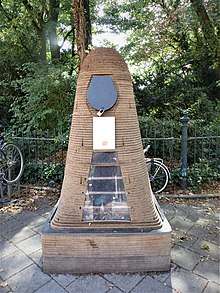
Worm Hotels accommodate useful worm in ideal conditions.
Related technologies
Organic ingredients intended for composting can also be used to generate biogas through anaerobic digestion. This process stabilizes organic material. The residual material, sometimes in combination with sewage sludge can be treated by a composting process before selling or giving away the compost.[37]
Regulations
There are process and product guidelines in Europe that date to the early 1980s (Germany, the Netherlands, Switzerland) and only more recently in the UK and the US. In both these countries, private trade associations within the industry have established loose standards, some say as a stop-gap measure to discourage independent government agencies from establishing tougher consumer-friendly standards.[38]
The USA is the only Western country that does not distinguish sludge-source compost from green-composts, and by default in the USA 50% of states expect composts to comply in some manner with the federal EPA 503 rule promulgated in 1984 for sludge products.[39]
Compost is regulated in Canada[40] and Australia[41] as well.
Many countries such as Wales[42][43] and some individual cities such as Seattle and San Francisco require food and yard waste to be sorted for composting (San Francisco Mandatory Recycling and Composting Ordinance).[44][45]
Examples
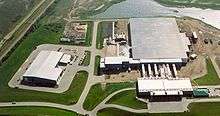
Large-scale composting systems are used by many urban areas around the world.
- The world's largest municipal co-composter for municipal solid waste (MSW) is the Edmonton Composting Facility in Edmonton, Alberta, Canada, which turns 220,000 tonnes of municipal solid waste and 22,500 dry tonnes of sewage sludge per year into 80,000 tonnes of compost. The facility is 38,690 m2 (416,500 sq ft) in area, equivalent to 4½ Canadian football fields, and the operating structure is the largest stainless steel building in North America.
- In 2006, Qatar awarded Keppel Seghers Singapore, a subsidiary of Keppel Corporation, a contract to begin construction on a 275,000 tonne/year anaerobic digestion and composting plant licensed by Kompogas Switzerland. This plant, with 15 independent anaerobic digesters, will be the world's largest composting facility once fully operational in early 2011 and forms part of Qatar's Domestic Solid Waste Management Centre, the largest integrated waste management complex in the Middle East.
- Another large municipal solid waste composter is the Lahore Composting Facility in Lahore, Pakistan, which has a capacity to convert 1,000 tonnes of municipal solid waste per day into compost. It also has a capacity to convert substantial portion of the intake into refuse-derived fuel (RDF) materials for further combustion use in several energy consuming industries across Pakistan, for example in cement manufacturing companies where it is used to heat cement kilns. This project has also been approved by the Executive Board of the United Nations Framework Convention on Climate Change for reducing methane emissions, and has been registered with a capacity of reducing 108,686 tonnes carbon dioxide equivalent per annum.[46]
- Kew Gardens in London has one of the biggest non-commercial compost heaps in Europe.
- Compost is used as a soil amendment in organic farming.
- Within an EU project conducted in Portugal and Spain, organic compost has been successfully used to revive degraded landscapes by improving the quality of soil.[47]
Commercial composts
The term “compost” can also refer to potting mixes which are bagged up and sold commercially in garden centres and other outlets.[48] This may include composted materials such as manure and peat, but is also likely to contain loam, fertilisers, sand, grit, etc. Varieties include multi-purpose composts designed for most aspects of planting, John Innes formulations [48], growbags, designed to have crops such as tomatoes directly planted into them. There are also a range of specialist composts available, e.g. for vegetables, orchids, houseplants, hanging baskets, roses, ericaceous plants, seedlings, potting on etc.
History
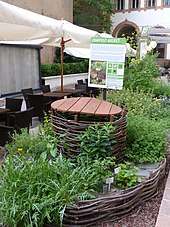
Composting as a recognized practice dates to at least the early Roman Empire, and was mentioned as early as Cato the Elder's 160 BCE piece De Agri Cultura.[49] Traditionally, composting involved piling organic materials until the next planting season, at which time the materials would have decayed enough to be ready for use in the soil. The advantage of this method is that little working time or effort is required from the composter and it fits in naturally with agricultural practices in temperate climates. Disadvantages (from the modern perspective) are that space is used for a whole year, some nutrients might be leached due to exposure to rainfall, and disease-producing organisms and insects may not be adequately controlled.
Composting was somewhat modernized beginning in the 1920s in Europe as a tool for organic farming.[50] The first industrial station for the transformation of urban organic materials into compost was set up in Wels, Austria in the year 1921.[51] Early frequent citations for propounding composting within farming are for the German-speaking world Rudolf Steiner, founder of a farming method called biodynamics, and Annie Francé-Harrar, who was appointed on behalf of the government in Mexico and supported the country 1950–1958 to set up a large humus organization in the fight against erosion and soil degradation.[52]
In the English-speaking world it was Sir Albert Howard who worked extensively in India on sustainable practices and Lady Eve Balfour who was a huge proponent of composting. Composting was imported to America by various followers of these early European movements by the likes of J.I. Rodale (founder of Rodale Organic Gardening), E.E. Pfeiffer (who developed scientific practices in biodynamic farming), Paul Keene (founder of Walnut Acres in Pennsylvania), and Scott and Helen Nearing (who inspired the back-to-the-land movement of the 1960s). Coincidentally, some of the above met briefly in India - all were quite influential in the U.S. from the 1960s into the 1980s.
Society and culture
Terminology
The term "composting" is used worldwide with differing meanings.
"Humanure" is a portmanteau of human and manure, designating human excrement (feces and urine) that is recycled via composting for agricultural purposes. The term was first used in 1994 in a book by Joseph Jenkins that advocates the use of this organic soil amendment.[53] The term humanure is used by compost enthusiasts in the United States but not widely used elsewhere.[5] Because the term "humanure" has no authoritative definition it is subject to various uses. News reporters may use the term also for sewage sludge or biosolids.[54]
See also
- Carbon farming
- Organic farming
- Permaculture
- Soil science
- Sustainable agriculture
- Terra preta
- Urban agriculture
- Waste sorting
- Zero waste
Related lists
- List of composting systems
- List of environment topics
- List of sustainable agriculture topics
- List of organic gardening and farming topics
References
- Masters, Gilbert M. (1997). Introduction to Environmental Engineering and Science. Prentice Hall. ISBN 9780131553842.
- "Composting for the Homeowner - University of Illinois Extension". Web.extension.illinois.edu. Archived from the original on 24 February 2016. Retrieved 18 July 2013.
- "Composting for the Homeowner -Materials for Composting". uiuc.edu. Archived from the original on 25 December 2009. Retrieved 13 April 2010.
- Lal, Rattan (30 November 2003). "Composting". Pollution a to Z. 1.
- Tilley, Elizabeth; Ulrich, Lukas; Lüthi, Christoph; Reymond, Philippe; Zurbrügg, Chris (2014). "Septic tanks". Compendium of Sanitation Systems and Technologies (2nd ed.). Duebendorf, Switzerland: Swiss Federal Institute of Aquatic Science and Technology (Eawag). ISBN 978-3-906484-57-0.
- Haug, Roger (23 July 1993). The Practical Handbook of Compost Engineering. CRC Press. ISBN 9780873713733. Retrieved 26 October 2015.
- Klickitat County WA, USA Compost Mix Calculator Archived 17 November 2011 at the Wayback Machine
- "Chapter 1, The Decomposition Process". aggie-horticulture.tamu.edu. Retrieved 11 July 2016.
- "How to Make Compost at Home". asthegardenturns.com. Retrieved 11 July 2016.
- "Composting - Compost Microorganisms". Cornell University. Retrieved 6 October 2010.
- "The Rapid Compost Method by Robert Raabe, Professor of Plant Pathology, Berkeley" (PDF). Retrieved 21 December 2017.
- Dougherty, Mark. (1999). Field Guide to On-Farm Composting. Ithaca, New York: Natural Resource, Agriculture, and Engineering Service.
- Domingo, J. L.; Nadal, M. (August 2012). "Domestic waste composting facilities: a review of human health risks". Environment International. 35 (2): 382–9. doi:10.1016/j.envint.2008.07.004. PMID 18701167.
- "Stockholm Environment Institute - EcoSanRes - Guidelines on the Use of Urine and Feces in Crop Production" (PDF). Archived from the original (PDF) on 30 December 2010. Retrieved 14 July 2010.
- EPA,OSWER,ORCR, US (16 April 2013). "Reduce, Reuse, Recycle - US EPA" (PDF). US EPA. Retrieved 21 December 2017.CS1 maint: multiple names: authors list (link)
- Morel, P.; Guillemain, G. (2004). "Assessment of the possible phytotoxicity of a substrate using an easy and representative biotest". Acta Horticulturae (644): 417–423. doi:10.17660/ActaHortic.2004.644.55.
- Itävaara et al. Compost maturity - problems associated with testing. in Proceedings of Composting. Innsbruck Austria 18-21.10.2000
- Aslam DN, et al. (2008). "Development of models for predicting carbon mineralization and associated phytotoxicity in compost-amended soil". Bioresour Technol. 99 (18): 8735–8741. doi:10.1016/j.biortech.2008.04.074. PMID 18585031.
- "The Effect of Lignin on Biodegradability - Cornell Composting". cornell.edu.
- Bahramisharif, Amirhossein; Rose, Laura E. (2019). "Efficacy of biological agents and compost on growth and resistance of tomatoes to late blight". Planta. 249 (3): 799–813. doi:10.1007/s00425-018-3035-2. ISSN 1432-2048. PMID 30406411.
- "Paper on Invasive European Worms". 21 January 2009. Retrieved 22 February 2009.
- Stenström, T.A., Seidu, R., Ekane, N., Zurbrügg, C. (2011). Microbial exposure and health assessments in sanitation technologies and systems - EcoSanRes Series, 2011-1. Stockholm Environment Institute (SEI), Stockholm, Sweden, page 88
- Diener, Stefan; Studt Solano, Nandayure M.; Roa Gutiérrez, Floria; Zurbrügg, Christian; Tockner, Klement (2011). "Biological Treatment of Municipal Organic Waste using Black Soldier Fly Larvae". Waste and Biomass Valorization. 2 (4): 357–363. doi:10.1007/s12649-011-9079-1. ISSN 1877-2641.
- Booth, Donald C.; Sheppard, Craig (1 April 1984). "Oviposition of the Black Soldier Fly, Hermetia illucens (Diptera: Stratiomyidae): Eggs, Masses, Timing, and Site Characteristics". Environmental Entomology. 13 (2): 421–423. doi:10.1093/ee/13.2.421. ISSN 0046-225X.
- Lalander, Cecilia; Diener, Stefan; Magri, Maria Elisa; Zurbrügg, Christian; Lindström, Anders; Vinnerås, Björn (2013). "Faecal sludge management with the larvae of the black soldier fly (Hermetia illucens) — From a hygiene aspect". Science of the Total Environment. 458–460: 312–318. doi:10.1016/j.scitotenv.2013.04.033. PMID 23669577.
- Banks, Ian J.; Gibson, Walter T.; Cameron, Mary M. (1 January 2014). "Growth rates of black soldier fly larvae fed on fresh human faeces and their implication for improving sanitation". Tropical Medicine & International Health. 19 (1): 14–22. doi:10.1111/tmi.12228. ISSN 1365-3156. PMID 24261901.
- Lalander, Cecilia; Nordberg, Åke; Vinnerås, Björn (2018). "A comparison in product-value potential in four treatment strategies for food waste and faeces – assessing composting, fly larvae composting and anaerobic digestion". GCB Bioenergy. 10 (2): 84–91. doi:10.1111/gcbb.12470. ISSN 1757-1707.
- Li, Qing; Zheng, Longyu; Cai, Hao; Garza, E.; Yu, Ziniu; Zhou, Shengde (2011). "From organic waste to biodiesel: Black soldier fly, Hermetia illucens, makes it feasible". Fuel. 90 (4): 1545–1548. doi:10.1016/j.fuel.2010.11.016.
- "E". Bio-Conversion of Putrescent Waste. ESR International. Archived from the original on 16 May 2016. Retrieved 17 April 2015.
- Haug, Roger Tim (1993). The Practical Handbook of Compost Engineering. Lewis Publishers. ISBN 0-87371-373-7.
- "hugelkultur: the ultimate raised garden beds". Richsoil.com. 27 July 2007. Retrieved 18 July 2013.
- "The Art and Science of Making a Hugelkultur Bed - Transforming Woody Debris into a Garden Resource Permaculture Research Institute - Permaculture Forums, Courses, Information & News". 3 August 2010. Archived from the original on 5 November 2015. Retrieved 18 July 2013.
- "Hugelkultur: Composting Whole Trees With Ease Permaculture Research Institute - Permaculture Forums, Courses, Information & News". 4 January 2012. Archived from the original on 28 September 2015. Retrieved 18 July 2013.
- Hemenway, Toby (2009). Gaia's Garden: A Guide to Home-Scale Permaculture. Chelsea Green Publishing. pp. 84–85. ISBN 978-1-60358-029-8.
- Gómez-Brandón, M; Vela, M; Martinez Toledo, MV; Insam, H; Domínguez, J (2015). "12: Effects of Compost and Vermiculture Teas as Organic Fertilizers". In Sinha, S; Plant, KK; Bajpai, S (eds.). Advances in Fertilizer Technology: Synthesis (Vol1). Stadium Press LLC. pp. 300–318. ISBN 978-1-62699-044-9.
- Santos, M; Dianez, F; Carretero, F (2011). "12: Suppressive Effects of Compost Tea on Phytopathogens". In Dubey, NK (ed.). Natural products in plant pest management. Oxfordshire, UK Cambridge, MA: CABI. pp. 242–262. ISBN 9781845936716.
- Dawson, Lj. "How Cities Are Turning Food Into Fuel". POLITICO. Retrieved 28 February 2020.
- "US Composting Council". Compostingcouncil.org. Retrieved 18 July 2013.
- "Electronic Code of Federal Regulations. Title 40, part 503. Standards for the use or disposal of sewage sludge". U.S. Government Printing Office. 1998. Retrieved 30 March 2009.
- "Canadian Council of Ministers of the Environment - Guidelines for Compost Quality" (PDF). CCME Documents. 2005. Archived from the original (PDF) on 18 October 2015. Retrieved 4 September 2017.
- "Organics Recycling In Australia". BioCycle. 2011. Retrieved 4 September 2017.
- "Gwynedd Council food recycling". Archived from the original on 1 May 2014. Retrieved 21 December 2017.
- "Anglesey households achieve 100% food waste recycling". edie.net.
- "Recycling & Composting in San Francisco - Frequently Asked Questions". San Francisco Dept. of the Environment. 2016. Retrieved 4 September 2017.
- Tyler, Aubin (21 March 2010). "The case for mandatory composting". The Boston Globe. Retrieved 19 September 2010.
- Details on project design and its validation and monitoring reports are available at: Project 2778 : Composting of Organic Content of Municipal Solid Waste in Lahore
- Velez, Aurora (20 January 2020). "Degraded land begins to bloom thanks to European composting project". euronews. Retrieved 24 January 2020.
- "John Innes potting compost". Royal Horticultural Society. Retrieved 7 August 2020.
- Cato, Marcus (160 BCE). "37.2; 39.1". De Agri Cultura. Check date values in:
|year=(help) - "History of Composting". illinois.edu. Archived from the original on 4 October 2018. Retrieved 11 July 2016.
- Welser Anzeiger vom 05. Januar 1921, 67. Jahrgang, Nr. 2, S. 4
- Laws, Bill (19 June 2014). A History of the Garden in Fifty Tools. University of Chicago Press. p. 86. ISBN 9780226139937.
- Jenkins, J.C. (2005). The Humanure Handbook: A Guide to Composting Human Manure. Grove City, PA: Joseph Jenkins, Inc.; 3rd edition. p. 255. ISBN 978-0-9644258-3-5. Retrieved April 2011. Check date values in:
|accessdate=(help) - Courtney Symons (13 October 2011). "'Humanure' dumping sickens homeowner". YourOttawaRegion. Metroland Media Group Ltd. Retrieved 16 October 2011.
| Wikimedia Commons has media related to Compost. |
| Wikibooks has a book on the topic of: Category:Composting |


